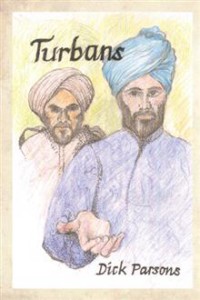Title: Turbans
Author: Dick Parsons
Publisher: AuthorHouseUK
ISBN: 9781491875438
Pages: 220
Genre: Historical Fiction
Reviewed by: Anita Lock
Buy on Amazon
Pacific Book Review
Trudi Leafe’s patrician British upbringing keeps her focused on learning and less on developing deep relationships, especially with her parents and grandparents. Fortunately, a bond of friendship grows between Trudi and Bill, her grandparent’s handyman/chauffeur, when he satisfies the appetite of “the bright enquiring child” by introducing her to “the names of birds, plants, and insects” the two find in the garden. Amid this delightful aspect of her childhood, Trudi learns the harsh truth that she is a bastard child, the daughter of none other than her governess. The momentary discomfort seems to pass until an opportunity to sail in 1939 arises during her later teen years to India, where her father officiates as High Court Judge in Allahabad.
A near two-week trip, the voyage is eventful. Aside from news reports of a war brewing in Europe, Trudi meets and falls in love with a naval Lieutenant named Richard Hooper. Although the lovers part ways in Bombay, they keep in contact via hand-written correspondence. Receiving letters from Richard offers a temporary happiness from the stuffy etiquette, her parent’s high-ranking parties, and other “petty restrictions of life” which surround Trudi. Looking for an opportunity to escape, Trudi accepts an invitation to join friends on a tour of India. It is during this trip that she learns the truth about her birth mother. Time passes before Trudi sees Richard and they have a short but poignant reunion. Although Richard proposes to Trudi, her happiness quickly shatters when she receives word a few months later that Richard’s ship had sunk.
Parsons pens a story of love, hardship, and perseverance. Parson’s narrative is a careful balance of fiction and historical data set during turbulent times of British-ruled India and World War II. Featuring the life of Trudi Leafe, a woman whose experiences take her beyond her aristocratic sphere, Parson’s storyline is laced with a host of characters many of whom serve as foils to better define his leading lady. Unique to plot design, Parson presents a side of WWII history that is infrequent to American historian literature of that period. While many stories center in Europe, Hawaii (Pearl Harbor), or life in the U.S., Parsons shines a light on South and Southeast Asia (India and Singapore, respectively).
Parsons writing style reflects Trudi’s aristocratic environs. Reading his storyline, one may quickly reflect on the sophisticated language used in James Cameron’s blockbuster movie Titanic. Keeping to the era, Parsons uses words—derogatory or otherwise—that may or may not be familiar to readers. That said, Parsons’ glossary of terms found at the end of the story focuses primarily on the military and Indian lingo. While the terms may slow down the reading process a bit, they do not encumber the flow of the plot. On the whole, Parsons’ narrative segues nicely from one chapter to the next. An additional sprinkling of hand-written diary entries and correspondence provides a personal touch to the storyline as well as eliminates any opportunities for reader boredom. Not meant for all, yet is a perfect read for WWII enthusiasts.



Follow Us